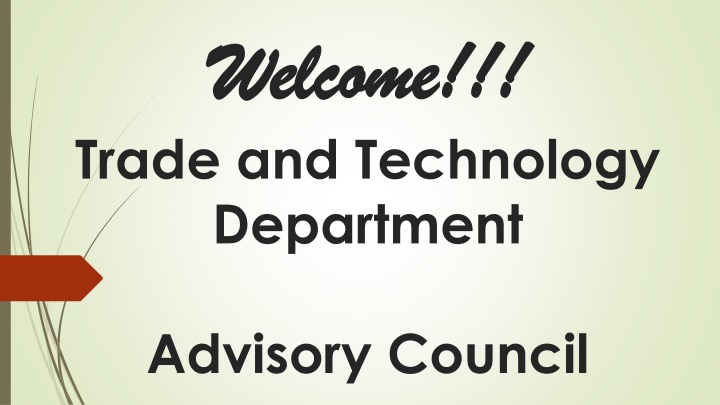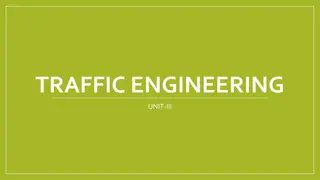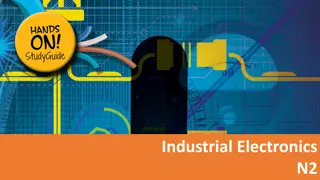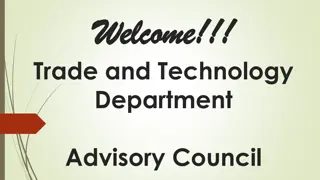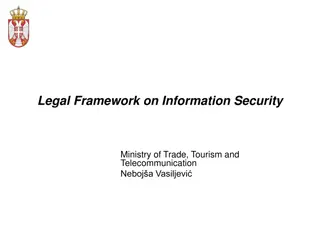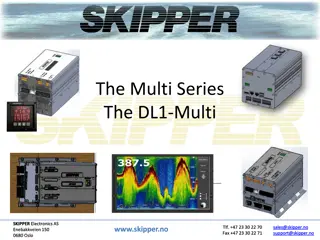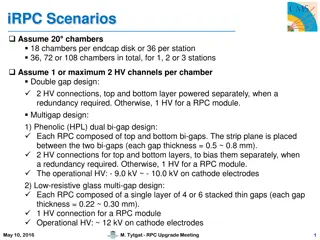Electronics and Telecommunication Technology Programs Overview
The Electronics Technology program provides students with academic courses, technical skills training, and practical experience to become electronics technicians, focusing on troubleshooting and repairing electronic appliances. Similarly, the Telecommunication Technology program prepares students for roles in the telecom industry, covering communication systems such as microwave and fiber optics. Both programs offer hands-on learning experiences and job-ready skills for these high-tech fields.
Download Presentation

Please find below an Image/Link to download the presentation.
The content on the website is provided AS IS for your information and personal use only. It may not be sold, licensed, or shared on other websites without obtaining consent from the author.If you encounter any issues during the download, it is possible that the publisher has removed the file from their server.
You are allowed to download the files provided on this website for personal or commercial use, subject to the condition that they are used lawfully. All files are the property of their respective owners.
The content on the website is provided AS IS for your information and personal use only. It may not be sold, licensed, or shared on other websites without obtaining consent from the author.
E N D
Presentation Transcript
Welcome!!! Welcome!!! Trade and Technology Department Advisory Council
Associate in Applied Science (AAS) Electronics Technology Telecommunication Certificate Program Electronics Engineering Technology
Electronics Technology The Electronics technology program offers academic course, technical skills training and practical experience to prepare the students for positions as technicians. Students are introduced to theory and practices in troubleshooting and repair of different electronic appliances. Maintenance, troubleshooting, repairing and modifying electronic equipment and systems is the base for a career as a technician in this high-tech field. The academic course, technical skills training and practical experience available in this program prepares students for employment as technicians in the rapidly growing electronics industry.
ELECTRONICS TECHNOLOGY PROGRAM LEARNING OUTCOMES (PLOs): At the end of the (AAS) electronics Technology, the student will be able to: 1. Practice safety and occupational health procedures in the workplace. 2. Use electronics tools and test equipment competently. 3. Interpret schematic diagrams and waveforms. 4. Build electronics project to a given specification. 5. Perform troubleshooting techniques to maintain and resolve hardware and software related problems in a personal computer. 6. Perform troubleshooting techniques to maintain, diagnose, and repair electronic equipment.
Telecommunication Technology The Telecommunication technology program offers academic course, technical skills training and practical experience to prepare the students for positions in the Telecom industry. Students work with communication systems such as microwave, fiber optics and telephone. Maintenance, troubleshooting, Telecommunication equipment and systems is the base for a career as a technician in this high-tech field. Telecommunications is one of the fastest growing industries in the world. The computer and information technologies are driving the need for more telecommunications services. This increase in services also drives the need for more qualified technicians. The academic course work, technical skills training and practical experience available in this program prepares the student for positions within the industry. repairing and modifying
TELECOMMUNICATION PROGRAM LEARNING OUTCOMES (PLOs): At the end of the (AAS) electronics Technology, the student will be able to: 1. Practice safety and occupational health procedures in the workplace. 2. Use electronics tools and test equipment competently. 3. Interpret schematic diagrams and waveforms. 4. Build electronics project to a given specification. 5. Practice a career in the Telecomm industry. 6. Troubleshoot microwave, fiber optic, radio communication and telephone system.
Electronics Engineering Technology Electronics offers academic course, technical skills, training and practical experience to prepare the students for positions in the Electronics industry. Engineering Technology program
ELECTRONICS ENGINEERING TECHNOLOGY PROGRAM LEARNING OUTCOMES (PLOs): At the end of the Electronics Engineering Technology, the student will be able to: 1. Practice safety and occupational health procedures in the workplace. 2. Use electronics tools and test equipment competently. 3. Interpret schematic diagrams and waveforms. 4. Build electronics project to a given specification.
Electronics Technology Semester Freshmen Fall Course Code Course Name Credit VSP 121 VEE 100 VEE 103 Industrial Safety Electronics Soldering and Mechanical Techniques Electronics Fundamentals I 1.5 1.5 3 Spring VEE 104 VEE 110 VEM 110 VEE 135 Electronics Fundamentals II Discrete Devices I Workshop Fabrication Digital Electronics I 4 3 3 3 Summer Sophomores Fall VEE 125 Electronics Circuits 3 VEE 223 VEE 222 VEE 235 VTE 281 PC Hardware and Software Discrete Devices II Digital electronics II Cellular Phone Repair 4 3 3 3 Spring VEE 224 VEE 225 VEE 240 Video System and Product Servicing Business Machine Servicing Signal Processing 4 4 3 46 Total
Telecommunication Semester Course Code Freshmen Fall VSP 121 VEE 100 VEE 103 Course Name Credit Industrial Safety Electronics Soldering and Mechanical Techniques Electronics Fundamentals I 1.5 1.5 3 Spring VEE 104 VEE 110 VEM 110 VEE 125 Electronics Fundamentals II Discrete Devices I Workshop Fabrication Electronics Circuits 4 3 3 3 Summer Sophomores Fall VEE 135 Digital Electronics I 3 VEE 230 VEE 240 VEE 235 VTE 281 Radio Communication Signal Processing Digital electronics II Cellular Phone Repair 3 3 3 3 Spring VTE 260 VTE 265 VTE 270 VTE 280 Microwave Fiber Optics Telecommunication System Telephone System 3 3 3 3 46 Total
Telecommunication Program Challenges Need more hands-on hours to practice the skills competencies. Alignment of the courses for third party certification preparation. * Fiber Optics Installer (FOI) by ETA * Telecommunication Technician (TCM) by ETA Rapid technological changes Digital Communication Gadgets (cellphones, tablets and telephones) RF communication (UHF and HF)
Electronics Program Challenges Need more hands-on hours to practice the skills competencies. Alignment of the courses for third party certification preparation. * Associate Electronics Technician (CETa) by ETA * Student Electronics Technician (SET) by ETA Rapid technological changes Video Equipment servicing and repair (LCD, LED, Smart TV, 7.1 home theater, Bluray, etc) Business Machine servicing and repair (Risograph, High-end photocopier, service manual, multifunction mchine, scanners)
Program Direction CoA AAS Electronics Technology Electronics Engineering Technology - Basic Troubleshooting Skills - Audio installer - Home - Car - Security camera installer - Certification SET (ETA) - Basic and Advance Troubleshooting Skills - Servicing of different Electronic Appliances - Certification CET (ETA)
Program Direction AAS Telecommunication - Basic and Advance Troubleshooting Skills for telecommunication systems. (RF Radio equipment, telecomm equipment and transmission mediums - Certification FOI fiber optics Installers - TCM Certification
End of Presentation!! Kalahngan!!
